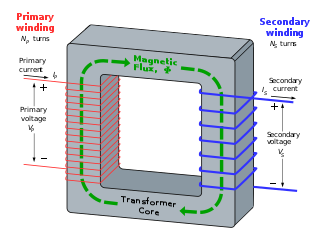Blog number:-020
Hello Everybody,
well, I hope you all will be fine.



Hello Everybody,
well, I hope you all will be fine.
In the last Blog, we started discussing about Electrical Machine. So basically we have two types of machine: 1. Rotating Machine and 2. Static Machine. Rotating Machine again classified further into two types: a. Motor and b. Generator. and Transformer is the static Machine. So, today we are going to discuss about Static Machine(Transformer).
Transformer:-
One of the main reasons that we use alternating AC voltages and currents in our homes and workplace’s is that AC supplies can be easily generated at a convenient voltage, transformed (hence the name transformer) into much higher voltages and then distributed around the country using a national grid and cables over very long distances.
Transformer is only eligible to convert one level of signal to other level of signal of AC Signal and it is not applied in case of DC signal.
The reason for transforming the voltage to a much higher level is that higher distribution voltages implies lower currents for the same power and therefore lower I2R losses along the networked grid of cables. These higher AC transmission voltages and currents can then be reduced to a much lower, safer and usable voltage level where it can be used to supply electrical equipment in our homes and workplaces, and all this is possible due to Voltage Transformer.
The Voltage Transformer can be thought of as an electrical component rather than an electronic component. A transformer basically is very simple static (or stationary) electro-magnetic passive electrical device that works on the principle of Faraday’s law of induction by converting electrical energy from one value to another.
The transformer does this by linking together two or more electrical circuits using a common oscillating magnetic circuit which is produced by the transformer itself. A transformer operates on the principals of “electromagnetic induction”, in the form of Mutual Induction. Mutual induction is the process by which a coil of wire magnetically induces a voltage into another coil located in close proximity to it. Transformers are capable of either increasing or decreasing the voltage and current levels of their supply, without modifying its frequency, or the amount of electrical power being transferred from one winding to another via the magnetic circuit.

A single phase voltage transformer basically consists of two electrical coils of wire, one called the “Primary Winding” and another called the “Secondary Winding”. The “primary” side of the transformer as the side that usually takes power, and the “secondary” as the side that usually delivers power. These two coils are not in electrical contact with each other but are instead wrapped together around a common closed magnetic iron circuit called the “core”. This soft iron core is not solid but made up of individual laminations connected together to help reduce the core’s losses.
The two coil winding are electrically isolated from each other but are magnetically linked through the common core allowing electrical power to be transferred from one coil to the other. When an electric current passed through the primary winding, a magnetic field is developed which induces a voltage into the secondary winding.
Representing Transformer
- Where:
- VP - is the Primary Voltage
- VS - is the Secondary Voltage
- NP - is the Number of Primary Windings
- NS - is the Number of Secondary Windings
- Φ (phi) - is the Flux Linkage
Notice that the two coil winding are not electrically connected but are only linked magnetically. A single-phase transformer can operate to either increase or decrease the voltage applied to the primary winding. When a transformer is used to “increase” the voltage on its secondary winding with respect to the primary, it is called a Step-up transformer. When it is used to “decrease” the voltage on the secondary winding with respect to the primary it is called a Step-down transformer. However, a third condition exists in which a transformer produces the same voltage on its secondary as is applied to its primary winding. In other words, its output is identical with respect to voltage, current and power transferred. This type of transformer is called an “Impedance Transformer” and is mainly used for impedance matching or the isolation of adjoining electrical circuits. The difference in voltage between the primary and the secondary winding is achieved by changing the number of coil turns in the primary winding ( NP ) compared to the number of coil turns on the secondary winding ( NS ). A ratio now exists between the number of turns of the primary coil divided by the number of turns of the secondary coil. This ratio, called the ratio of transformation, more commonly known as a transformers “turns ratio”, ( TR ).
So, Voltage on secondary winding is:-
Secondary Voltage(Vs)= n/{Primary Voltage(Vp)}
And Current through Secondary winding is:-
Secondary Current(Is)= n*{Primary Current(Ip)}
Power in Transformer
Power(primary)= Power(secondary)
Thank you.




No comments:
Post a Comment